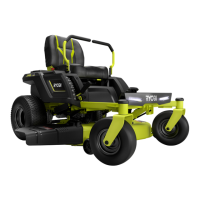
Do you have a question about the Ryobi Homelite RY48ZTR75/100 and is the answer not in the manual?
| Brand | Ryobi |
|---|---|
| Model | Homelite RY48ZTR75/100 |
| Category | Lawn Mower |
| Language | English |
Technicians trained in electricity should wear protective gear and exercise caution with dangerous voltages.
Details the Ryobi ZTR mower's electrical system, including brushless motors and controllers for blades and drive wheels.
Explains how brushless motors differ from brushed motors and their 3-wire configuration, warning against direct voltage application.
Describes features like blue text for jumping topics, printer-friendliness, and the inclusion of block diagrams and tips for gas machine technicians.
Visualizes the mower's electrical system flow, showing connections between batteries, controllers, switches, and motors.
Provides initial steps including checking connections, charging, and basic component tests before disassembly.
Offers detailed steps for diagnosing issues with the charger, key switch, fuses, relays, fuel gauge, and drive/blade systems.
Explains the typical DMM setup, focusing on the 'DIODE' function and test lead connections for measurements.
Details useful tools like a 12V/USB module, spade lugs, Ridgid 12V battery, and USB cables with alligator clips.
Identifies the physical locations of major electrical components on the ZTR mower, such as the seat switch, beeper, and controllers.
Illustrates the location and labeling of the 'Deck Motor Controller' and 'Drive Motor Controllers' with the passenger leg panel removed.
Explains how to disconnect the main battery using the seat access cover, noting the pressure required and secured connector half.
Details the procedure for testing the main fuse using a DMM in resistance mode, emphasizing proper disconnection and fuse replacement.
Guides on setting the DMM to DC Volts, engaging the PTO switch to load the battery, and placing probes for measurement.
Identifies the various controls on the mower's panel, including the power switch, headlights, speed controls, fuel gauge, and USB port.
Details testing the PTO switch for continuity in both pulled out (closed) and pushed in (open) states using a DMM.
Explains testing the headlight switch using DMM in Diode mode for LED light and Resistance mode for latching behavior.
Describes testing the momentary drive and cutting speed switches, noting they are closed when pressed and open when released.
Details measuring battery voltage at the fuel gauge/hour meter connections to verify its operation and approximate charge remaining.
Provides instructions for testing the key switch by measuring battery voltage with the DMM in DC Volts mode when the switch is on/off.
Guides on testing the USB port for 5V output by measuring voltage with a DMM and checking the USB power indicator LED.
Identifies the location of the zero switches at the base of each steering arm and shows their appearance.
Explains testing neutral switches for continuity when pressed (out position) and no continuity when not pressed using a DMM.
Details testing the headlight assembly by measuring 12V at the harness or applying 12V independently to the module.
Provides methods to test the accelerator for voltage at the harness and voltage change when turned independently.
Explains testing the brake switch by measuring DC Volts at the harness or Resistance independently, noting plunger action.
Details testing the beeper out of circuit by applying 12V and on the mower by checking voltage at the harness.
Guides on testing the normally open seat switch for continuity when pressed and 5VDC on the harness.
Explains testing blade controllers for short circuits, output resistance, and power/ground to output circuitry using DMM functions.
Details testing drive motor controllers for short circuits, output resistance, and performing diode checks on power and ground circuitry.
Instructs on disconnecting motors and measuring resistance between pins using a DMM, ignoring connector labels.
Details testing drive motors by unbolting phase wires and measuring resistance between motor wires using a DMM.
Explains testing hall sensors by measuring 4-5V power and then voltage fluctuations on signal wires while rotating the motor.
Describes testing hall sensors independently by applying 5V power and manually rotating the motor to check signal wire voltages.
Guides on testing the converter fuse for continuity and the converter itself for input voltage and 12V output.
Details testing the DC-DC converter fuse for continuity by removing the rubber cap and checking the fuse value.
Explains testing the relay by measuring 12V on small terminals and ~39V on large terminals, or by applying 12V independently for resistance.
Guides on testing the relay diode for forward voltage drop and reverse bias using a DMM in 'Diode' mode.
Details testing the charge port and interlock by using a jumper wire to observe mower shutdown and restart behavior.
Provides a procedure to test the battery charger by disconnecting the battery, connecting jumper wires, and verifying the LED status.
Lists common battery charger error codes (flashes) with their meanings and suggested solutions for troubleshooting.
Provides a table of beep codes, their descriptions, troubleshooting steps, and potential solutions for diagnosing mower issues.
Guides on testing the temperature sensor by measuring its resistance at room temperature and when heated, noting error code correlation.
Presents a detailed diagram of the mower's wire harness, showing component connections and pin assignments.
Outlines essential checks to perform before and after repairs, including brake activation, motor operation, and charging verification.
Offers advice for mechanical technicians transitioning to electric mowers, emphasizing the use of sensory tools for troubleshooting.
Defines key electrical terms like Voltage, Resistance, and Diode, along with their symbols and measurement techniques with a DMM.
Details the correct procedure for setting the DMM to measure DC voltage, including probe placement and ensuring the correct setting.
Explains how to measure resistance using a DMM, emphasizing that power must be OFF and correct probe placement.
Lists the dates and descriptions of changes made to the document, including added content and cosmetic updates.